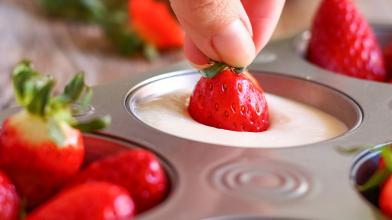People with diabetes are often told they shouldn’t eat sweet foods, including chocolate. But it can be hard to avoid during times of the year when there are traditions around chocolates, like getting chocolates as gifts during the holidays and heart-shaped boxes on Valentine’s Day.
For the times you want to enjoy a square or two during special occasions, or even during everyday life, the question is, “Can people with diabetes eat chocolate?” The good news is—the answer is yes! But it helps to understand which types are best and how to eat them in a way that fits into a balanced eating plan.
Different Types of Chocolate
Not all chocolate is created equal, especially when it comes to its impact on blood sugar (blood glucose) levels. Here's a breakdown of the main types of chocolate:
- Dark chocolate: Dark chocolate contains more cacao and less sugar content than milk or white chocolate. The higher the cacao content, the better. Look for dark chocolate with at least 70% cacao. Since it has less sugar than other chocolates, the carbohydrate content will be lower. Although, the higher the content of cacao, the higher the total fat and saturated fat content.
- Milk chocolate: Milk chocolate contains more sugar, more grams of carbohydrate, and fewer beneficial flavonoids than dark chocolate. It also typically contains added milk solids, which also contribute to a higher carb content.
- White chocolate: White chocolate is the least beneficial of the three types of chocolate, as it doesn’t contain cacao solids—only cocoa butter, sugar, and milk solids. It is higher in sugar and carbohydrate, making it less suitable for people with diabetes.
Health Benefits of Dark Chocolate
Dark chocolate, particularly those with higher cacao content (70% or higher), offers several health benefits:
- Heart health: Dark chocolate contains flavonoids which may help lower blood pressure and reduce the risk of heart disease by improving blood vessel function.
- Significant source of nutrients: Dark chocolate is a good source of minerals like iron, magnesium, and zinc.
- Antioxidants: The flavonoids in dark chocolate are also antioxidants that may help protect cells from damage caused by free radicals, contributing to overall health.
A study was published in the British Medical Journal that investigated if chocolate could lower the risk of diabetes. The study found the participants who consumed about 5 ounces of any chocolate/week, had a lower risk of developing type 2 diabetes compared to those who rarely ate chocolate. Those that ate dark chocolate had an even lower risk of developing diabetes. It is important to note that studies like these highlight overall patterns. For example, those who eat dark chocolate may also have other healthy lifestyle choices, like an eating plan or activity level that lower their risk of developing diabetes. It does not mean you should start eating dark chocolate to reduce your risk of diabetes.
While dark chocolate offers some health benefits, it's important to remember that it still contains carbohydrates, fat, and saturated fat. Moderation is key to enjoying it as part of your eating plan.
How to Fit Chocolate into Your Eating Plan
To enjoy chocolate while managing blood glucose levels, follow these tips:
- Choose dark chocolate: Opt for chocolate with at least 70% cacao content. Dark chocolate typically contains less sugar and offers more health benefits, making it a better choice for people with diabetes.
- Check the nutrition facts: Always check the serving size and total carbohydrate content. Keep your portion small, such as one or two squares, to manage your carbohydrate intake.
- Pair with a balanced meal: Enjoy your chocolate as part of a balanced meal that includes non-starchy vegetables, lean protein (like chicken, fish, or tofu), and a quality carbohydrate like whole grains, starchy vegetables, or fruit. This can help provide overall nutritional balance while fitting chocolate into your eating plan. (Pro tip: Remember to account for the carbohydrate from the chocolate)
Dark Chocolate Recipes for People with Diabetes
Check out some of our delicious dark chocolate recipes:
Nutrition Facts of Different Chocolates
| Type of Chocolate (serving: 1 square) | Carbohydrate (grams) | Fat (grams) | Saturated Fat (grams) |
| Dark with 92% cacao | 3 | 6 | 4 |
| Dark with 86% cacao | 4 | 6 | 4 |
| Dark with 72% cacao | 5 | 5 | 3 |
| Milk chocolate | 6 | 3.5 | 2 |
| White chocolate | 5 | 3 | 2 |
The Takeaway
If you have diabetes, chocolate doesn’t have to be off-limits. But choosing the right type and enjoying it in moderation is essential. Dark chocolate with high cacao content is generally your best option for enjoying a sweet treat that fits into a balanced eating plan. Always be mindful of portion sizes and have chocolate with healthy foods to help reach your blood glucose targets. By being mindful of how you eat chocolate, you can fit it into your eating plan.
Don’t forget to sign up for Diabetes Food Hub’s e-newsletter for diabetes-friendly ideas and recipes!














